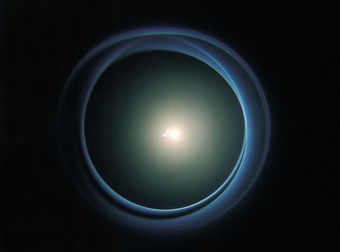Cherenkov radiation is one of the main techniques for particle identification, but details of the underlying theory are still under debate. A group of researchers from Comenius University, Bratislava, CERN and JINR recently carried out measurements using CERN’s high-energy beam of lead ions. With the assistance of the NA49 experiment, they used air, helium and various crystals as media.

The photo shows the result of passing the beam through a biaxial crystal of triglycine sulphate. The circle is the image of the Cherenkov radiation via the focusing lens, and the two elliptical bands are the Cherenkov radiation (the crystal has two different refractive indices). The light is also not uniform due to the alignment of the optical axis of the crystal.
Cherenkov radiation derives its name from Pavel Cherenkov, who as a young PhD student at Moscow’s Lebedev Institute in the early 1930s, was assigned by Sergei Vavilov the task of investigating what happens to the radiation from a piece of radium when it is immersed in a fluid. Such radioactive materials give off an eerie blue light, such as that seen in a “swimming pool” nuclear reactor.
Initially, this was thought to be fluorescence, similar to that seen when X-rays strike a screen, but Vavilov and Cherenkov were not convinced. After heroic investigations, where Cherenkov would typically prepare for a working day by staying in a totally dark room for one hour, he found that the radiation was produced by electrons and was essentially independent of the liquid used, thereby ruling out fluorescence.
The explanation for the effect came in 1937 from Ilya Frank and Igor Tamm, who explained that the radiation is a shock wave resulting from a charged particle moving through a material faster than the velocity of light in the material the optical equivalent of the sonic boom produced by an aircraft as it accelerates beyond the speed of sound.
The “Cherenkov” radiation propagates as a cone whose opening angle depends on the particle velocity. When this cone hits a flat surface, a characteristic ring is seen.
Further elucidation came in the 1950s when Cherenkov rings were photographed by Valentin Zrelov using proton beams at the Joint Institute for Nuclear Research (JINR), Dubna, near Moscow. In 1958, Cherenkov, Frank and Tamm shared the Nobel prize for their work. Vavilov had died earlier.





